Moran M.J., Shapiro H.N. Fundamentals of Engineering Thermodynamics
Подождите немного. Документ загружается.


596 Chapter 12 Ideal Gas Mixture and Psychrometric Applications
Assumptions:
1. The control volume shown in the accompanying figure operates at steady state.
2. The changes in kinetic and potential energy between inlet and exit can be ignored and
3. The entering and exiting moist air streams can be regarded as ideal gas mixtures.
Analysis:
(a) The heat transfer rate can be determined from the mass and energy rate balances. At steady state, the amounts of dry
air and water vapor contained within the control volume cannot vary. Thus, for each component individually it is necessary
for the incoming and outgoing mass flow rates to be equal. That is
For simplicity, the constant mass flow rates of the dry air and water vapor are denoted, respectively, by and . From these
considerations, it can be concluded that the humidity ratio is the same at the inlet and exit:
1
2
.
The steady-state form of the energy rate balance reduces with assumption 2 to
In writing this equation, the incoming and outgoing moist air streams are regarded as ideal gas mixtures of dry air and water
vapor.
Solving for
Noting that , where is the humidity ratio, the expression for can be written in the form
(1)
To evaluate from this expression requires the specific enthalpies of the dry air and water vapor at the inlet and exit, the
mass flow rate of the dry air, and the humidity ratio.
The specific enthalpies of the dry air are obtained from Table A-22 at the inlet and exit temperatures T
1
and T
2
, respec-
tively: h
a1
283.1 kJ/kg, h
a2
303.2 kJ/kg. The specific enthalpies of the water vapor are found using h
v
h
g
and data from
Table A-2 at T
1
and T
2
, respectively: h
g1
2519.8 kJ/kg, h
g2
2556.3 kJ/kg.
The mass flow rate of the dry air can be determined from the volumetric flow rate at the inlet (AV)
1
In this equation, v
a1
is the specific volume of the dry air evaluated at T
1
and the partial pressure of the dry air p
a1
. Using the
ideal gas equation of state
The partial pressure p
a1
can be determined from the mixture pressure p and the partial pressure of the water vapor p
v1
: p
a1
p p
v1
. To find p
v1
, use the given inlet relative humidity and the saturation pressure at 10C from Table A-2
Since the mixture pressure is 1 bar, it follows that p
a1
0.9902 bar. The specific volume of the dry air is then
v
a1
a
8314
28.97
N
#
m
kg
#
K
b1283 K2
10 .9902 10
5
N/m
2
2
0.82 m
3
/kg
p
v1
f
1
p
g1
10.82 10.01228 bar2 0.0098 bar
v
a1
1R
M2 T
1
p
a1
m
#
a
1AV2
1
v
a1
Q
#
cv
Q
#
cv
m
#
a
31h
a2
h
a1
2 v
1h
v2
h
v1
24
Q
#
cv
m
#
v
vm
#
a
Q
#
cv
m
#
a
1h
a2
h
a1
2 m
#
v
1h
v2
h
v1
2
Q
#
cv
0 Q
#
cv
W
#
0
cv
1m
#
a
h
a1
m
#
v
h
v1
2 1m
#
a
h
a2
m
#
v
h
v2
2
m
#
v
m
#
a
m
#
v1
m
#
v2
1water2
m
#
a1
m
#
a2
1dry air2
Q
#
cv
W
#
cv
0.
❶

12.8 Analyzing Air-Conditioning Processes 597
Using this value, the mass flow rate of the dry air is
The humidity ratio can be found from
Finally, substituting values into Eq. (1) we get
(b) The states of the water vapor at the duct inlet and exit are located on the accompanying T–v diagram. Both the
composition of the moist air and the mixture pressure remain constant, so the partial pressure of the water vapor at the
exit equals the partial pressure of the water vapor at the inlet: p
v2
p
v1
0.0098 bar. The relative humidity at the exit
is then
where p
g2
is from Table A-2 at 30C.
Alternative Psychrometric Chart Solution: Let us consider an alternative solution using the psychrometric chart. As shown
on the sketch of the psychrometric chart, Fig. E12.10b, the state of the moist air at the inlet is defined by
1
80% and a
dry-bulb temperature of 10C. From the solution to part (a), we know that the humidity ratio has the same value at the exit
as at the inlet. Accordingly, the state of the moist air at the exit is fixed by
2
1
and a dry-bulb temperature of 30C. By
inspection of Fig. A-9, the relative humidity at the duct exit is about 23%, and thus in agreement with the result of part (b).
The rate of heat transfer can be evaluated from the psychrometric chart using the following expression obtained by rear-
ranging Eq. (1) of part (a) to read
(2)
To evaluate from this expression requires values for the mixture enthalpy per unit mass of dry air (h
a
h
v
) at the in-
let and exit. These can be determined by inspection of the psychrometric chart, Fig. A-9, as (h
a
h
v
)
1
25.7 kJ/kg (dry
air), (h
a
h
v
)
2
45.9 kJ/kg (dry air).
Using the specific volume value v
a1
from the chart at the inlet state together with the given volumetric flow rate at the in-
let, the mass flow rate of the dry air is found as
Substituting values into the energy rate balance, Eq. (2), we get
which agrees closely with the result obtained in part (a), as expected.
3737
kJ
min
Q
#
cv
185
kg1dry air2
min
145.9 25.72
kJ
kg1dry air2
m
#
a
150 m
3
/min
0.81 m
3
/kg1dry air2
185
kg1dry air2
min
Q
#
cv
Q
#
cv
m
#
a
31h
a
vh
v
2
2
1h
a
vh
v
2
1
4
f
2
p
v2
p
g2
0.0098
0.04246
0.231
123.1%2
3717 kJ/min
Q
#
cv
182.9 31303.2 283.12 10.006162 12556.3 2519.824
0.00616
kg 1vapor2
kg 1dry air2
v 0.622
a
p
v1
p p
v1
b 0.622 a
0.0098
1 0.0098
b
m
#
a
150 m
3
/min
0 .82 m
3
/kg
182.9 kg/min
❷
❸

598 Chapter 12 Ideal Gas Mixture and Psychrometric Applications
Mixture enthalpy
10°C30°C
Dry-bulb temperature
= 100%
φ
= 80%
φ
12
ω
2
=
ω
1
ω
The first underlined term in this equation for is evaluated with specific enthalpies from the ideal gas table for air,
Table A-22. Steam table data are used to evaluate the second underlined term. Note that the different datums for enthalpy
underlying these tables cancel because each of the two terms involves enthalpy differences only. Since the specific heat
c
pa
for dry air varies only slightly over the interval from 10 to 30C (Table A-20), the specific enthalpy change of the dry
air could be evaluated alternatively with c
pa
1.005 kJ/kg K.
No water is added or removed as the moist air passes through the duct at constant pressure; accordingly, the humidity ra-
tio and the partial pressures p
v
and p
a
remain constant. However, because the saturation pressure increases as the tem-
perature increases from inlet to exit, the relative humidity decreases:
2
1
.
The mixture pressure, 1 bar, differs slightly from the pressure used to construct the psychrometric chart, 1 atm. This dif-
ference is ignored.
#
Q
#
cv
Figure E12.10b
❶
❷
❸
12.8.3 Dehumidification
When a moist air stream is cooled at constant mixture pressure to a temperature below its
dew point temperature, some condensation of the water vapor initially present would occur.
Figure 12.11 shows the schematic of a dehumidifier using this principle. Moist air enters at
state 1 and flows across a cooling coil through which a refrigerant or chilled water circu-
lates. Some of the water vapor initially present in the moist air condenses, and a saturated
moist air mixture exits the dehumidifier section at state 2. Although water would condense
at various temperatures, the condensed water is assumed to be cooled to T
2
before it exits
the dehumidifier. Since the moist air leaving the humidifier is saturated at a temperature lower
than the temperature of the moist air entering, the moist air stream might be unsuitable for
direct use in occupied spaces. However, by passing the stream through a following heating
section, it can be brought to a condition most occupants would regard as comfortable. Let
us sketch the procedure for evaluating the rates at which condensate exits and refrigerant
circulates.
MASS BALANCE. The mass flow rate of the condensate can be related to the mass flow
rate of the dry air by applying conservation of mass separately for the dry air and water
passing through the dehumidifier section. At steady state
m
#
v1
m
#
w
m
#
v2
1water2
m
#
a1
m
#
a2
1dry air2
m
#
a
m
#
w
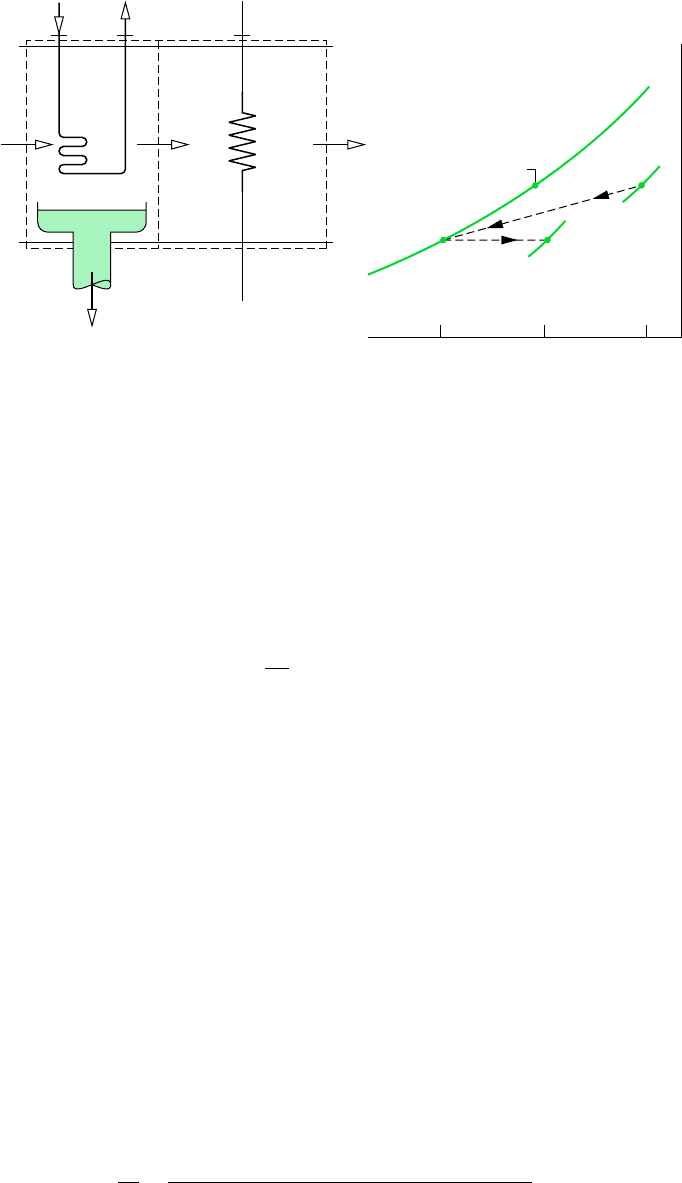
12.8 Analyzing Air-Conditioning Processes 599
The common mass flow rate of the dry air is denoted as . Solving for the mass flow rate
of the condensate
Introducing and , the amount of water condensed per unit mass of
dry air passing through the device is
This expression requires the humidity ratios
1
and
2
. Because no moisture is added or re-
moved in the heating section, it can be concluded from conservation of mass that
2
3
,
so
3
can be used in the above equation in place of
2
.
ENERGY BALANCE. The mass flow rate of the refrigerant through the cooling coil can
be related to the mass flow rate of the dry air by means of an energy rate balance applied
to the dehumidifier section. With negligible heat transfer with the surroundings,
and no significant kinetic and potential energy changes, the energy rate balance reduces at
steady state to
where h
i
and h
e
denote the specific enthalpy values of the refrigerant entering and exiting the
dehumidifier section, respectively. Introducing and (
1
2
)
where the specific enthalpies of the water vapor at 1 and 2 are evaluated at the saturated va-
por values corresponding to T
1
and T
2
, respectively. Since the condensate is assumed to exit
as a saturated liquid at T
2
, h
w
h
f2
. Solving for the refrigerant mass flow rate per unit mass
of dry air flowing through the device
m
#
r
m
#
a
1h
a1
h
a2
2 v
1
h
g1
v
2
h
g2
1v
1
v
2
2h
f2
h
e
h
i
0 m
#
r
1h
i
h
e
2 m
#
a
31h
a1
h
a2
2 v
1
h
g1
v
2
h
g2
1v
1
v
2
2h
f2
4
m
#
a
m
#
w
m
#
v1
v
1
m
#
a
, m
#
v2
v
2
m
#
a
,
0 m
#
r
1h
i
h
e
2 1m
#
a
h
a1
m
#
v1
h
v1
2 m
#
w
h
w
1m
#
a
h
a2
m
#
v2
h
v2
2
W
#
cv
0,
m
#
a
m
#
r
m
#
w
m
#
a
v
1
v
2
m
#
v2
v
2
m
#
a
m
#
v1
v
1
m
#
a
m
#
w
m
#
v1
m
#
v2
m
#
a
Figure 12.11 Dehumidification. (a) Equipment schematic. (b) Psychrometric chart
representation.
Initial dew
point
= 100%
φ
2
3
1
3
φ
1
φ
ω
T
2
T
3
T
1
Dry-bulb temperature
Cooling
coil
m
r
·
1
ie 32
Heating
coil
2
= 100%
2
< T
1
2
<
1
ω
φ
T
ω
T
3
> T
2
ω
3
=
ω
2
m
w
·
Condensate –
saturated at T
2
(Dehumidifier section) (Heating section)
(a)(b)
Moist air
m
a
,
T
1
,
1
,
p = 1 atm
ω
·
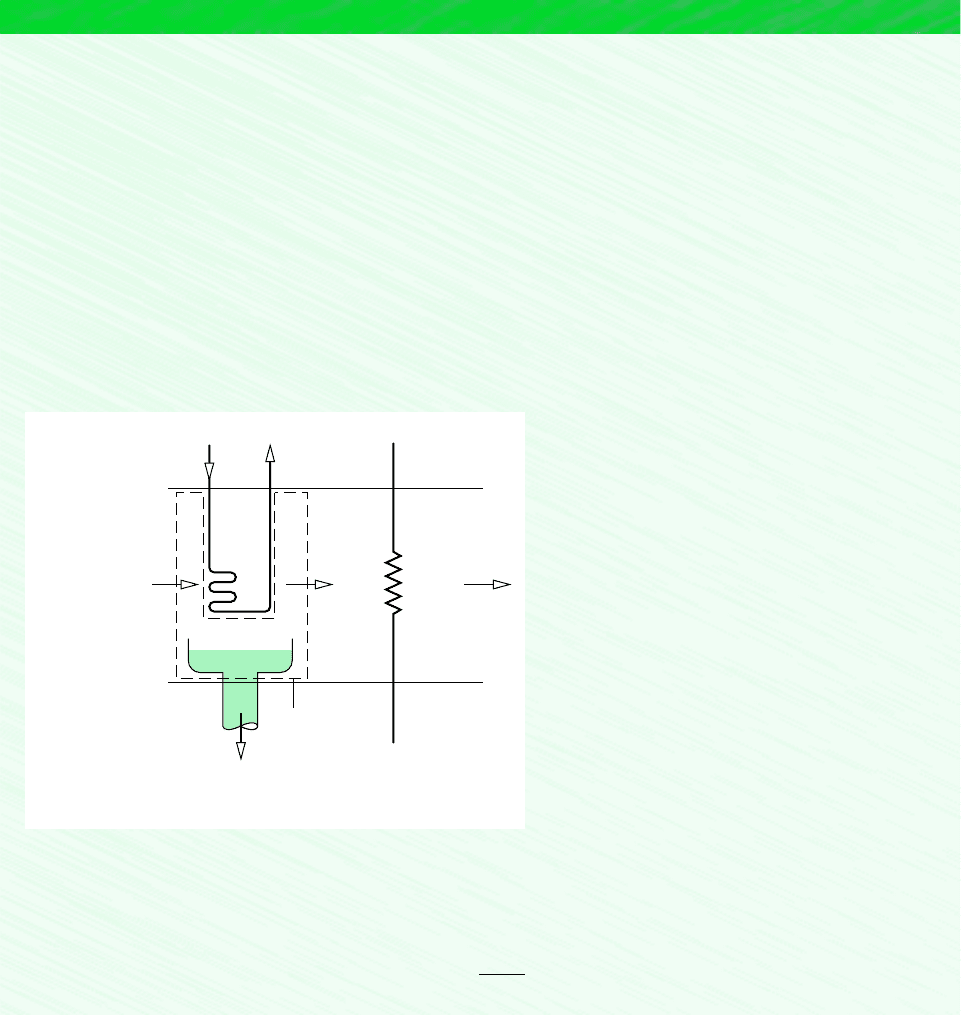
600 Chapter 12 Ideal Gas Mixture and Psychrometric Applications
The accompanying psychrometric chart, Fig. 12.11b, illustrates important features of the
processes involved. As indicated by the chart, the moist air first cools from state 1, where
the temperature is T
1
and the humidity ratio is
1
, to state 2, where the mixture is saturated
(
2
100%), the temperature is T
2
T
1
, and the humidity ratio is
2
1
. During the
subsequent heating process, the humidity ratio would remain constant,
2
3
, and the
temperature would increase to T
3
. Since the states visited would not be equilibrium states,
these processes are indicated on the psychrometric chart by dashed lines. The example to
follow provides a specific illustration.
EXAMPLE 12.11 Dehumidifier
Moist air at 30C and 50% relative humidity enters a dehumidifier operating at steady state with a volumetric flow rate of
280 m
3
/min. The moist air passes over a cooling coil and water vapor condenses. Condensate exits the dehumidifier saturated
at 10C. Saturated moist air exits in a separate stream at the same temperature. There is no significant loss of energy by heat
transfer to the surroundings and pressure remains constant at 1.013 bar. Determine
(a) the mass flow rate of the dry air, in
kg/min,
(b) the rate at which water is condensed, in kg per kg of dry air flowing through the control volume, and (c) the
required refrigerating capacity, in tons.
SOLUTION
Known: Moist air enters a dehumidifier at 30C and 50% relative humidity with a volumetric flow rate of 280 m
3
/min. Con-
densate and moist air exit in separate streams at 10C.
Determine: Find the mass flow rate of the dry air, in kg/min, the rate at which water is condensed, in kg per kg of dry air,
and the required refrigerating capacity, in tons.
Schematic and Given Data:
Heating coilCooling coil
Condensate,
saturated at
T
2
= 10°C
Control volume
13 2
Saturated
mixture
10°C
(AV)
1
T
1
1
= 280 m
3
/min
= 30°C
= 50%
φ
Analysis:
(a) At steady state, the mass flow rates of the dry air entering and exiting are equal. The common mass flow rate of the dry
air can be determined from the volumetric flow rate at the inlet
m
#
a
1AV2
1
v
a1
Figure E12.11
Assumptions:
1. The control volume shown in the accompanying
figure operates at steady state. Changes in kinetic and
potential energy can be neglected, and
2. There is no significant heat transfer to the
surroundings.
3. The pressure remains constant throughout at
1.013 bar.
4. At location 2, the moist air is saturated. The con-
densate exits at location 3 as a saturated liquid at tem-
perature T
2
.
W
#
cv
0.

12.8 Analyzing Air-Conditioning Processes 601
The specific volume of the dry air at inlet 1, v
a1
, can be evaluated using the ideal gas equation of state, so
The partial pressure of the dry air p
a1
can be determined from p
a1
p
1
p
v1
. Using the relative humidity at the inlet
1
and
the saturation pressure at 30C from Table A-2
Thus, p
a1
1.013 0.02123 0.99177 bar. Inserting values into the expression for gives
(b) Conservation of mass for the water requires With and the rate at which water
is condensed per unit mass of dry air is
The humidity ratios
1
and
2
can be evaluated using Eq. 12.43. Thus,
1
is
Since the moist air is saturated at 10C, p
v2
equals the saturation pressure at 10C: p
g
0.01228 bar from Table A-2. Equa-
tion 12.43 then gives
2
0.0076 kg(vapor)kg(dry air). With these values for
1
and
2
(c) The rate of heat transfer between the moist air stream and the refrigerant coil can be determined using an energy rate
balance. With assumptions 1 and 2, the steady-state form of the energy rate balance reduces to
With , and , this becomes
where the specific enthalpies of the water vapor at 1 and 2 are evaluated at the saturated vapor values corresponding to T
1
and
T
2
, respectively, and the specific enthalpy of the exiting condensate is evaluated as h
f
at T
2
. Selecting enthalpies from Tables A-2
and A-22, as appropriate
Since 1 ton of refrigeration equals a heat transfer rate of 211 kJ/min (Sec. 10.2), the required refrigerating capacity is 52.5 tons.
If a psychrometric chart were used to obtain data, this expression for would be rearranged to read
The underlined terms and humidity ratios
1
and
2
would be read directly from the chart; the specific enthalpy h
w
would
be obtained from Table A-2 as h
f
at T
2
.
Q
#
cv
m
#
a
31h
a
vh
v
2
2
1h
a
vh
v
2
1
1v
1
v
2
2
h
w
4
Q
#
cv
11,084 kJ/min
0.0076
12519.82 0.0057 142.0124
Q
#
cv
1319.352 31283.1 303.22 0.0133 12556.32
Q
#
cv
m
#
a
31h
a2
h
a1
2 v
1
h
g1
v
2
h
g2
1v
1
v
2
2
h
f2
4
m
#
w
1v
1
v
2
2
m
#
a
m
#
v1
v
1
m
#
a
, m
#
v2
v
2
m
#
a
0 Q
#
cv
1m
#
a
h
a1
m
#
v1
h
v1
2 m
#
w
h
w
1m
#
a
h
a2
m
#
v2
h
v2
2
Q
#
cv
m
#
w
m
#
a
0.0133 0.0076 0.0057
kg1condensate2
kg1dry air2
v
1
0.622 a
p
v1
p
1
p
v1
b 0.622 a
0.02123
0.99177
b 0.0133
kg1vapor2
kg1dry air2
m
#
w
m
#
a
v
1
v
2
m
#
v2
v
2
m
#
a
,m
#
v1
v
1
m
#
a
m
#
v1
m
#
v2
m
#
w
.
m
#
a
1280 m
3
/min2 10.99177 10
5
N/m
2
2
18314
28.97 N
#
m/kg
#
K2 1303 K2
319.35 kg/min
m
#
a
p
v1
f
1
p
g1
10.52 10.042462 0.02123 bar
m
#
a
1AV2
1
1R
M
a
2
1T
1
p
a1
2
❶
❶
12.8.4 Humidification
It is often necessary to increase the moisture content of the air circulated through occupied
spaces. One way to accomplish this is to inject steam. Alternatively, liquid water can be
sprayed into the air. Both cases are shown schematically in Fig. 12.12a. The temperature of
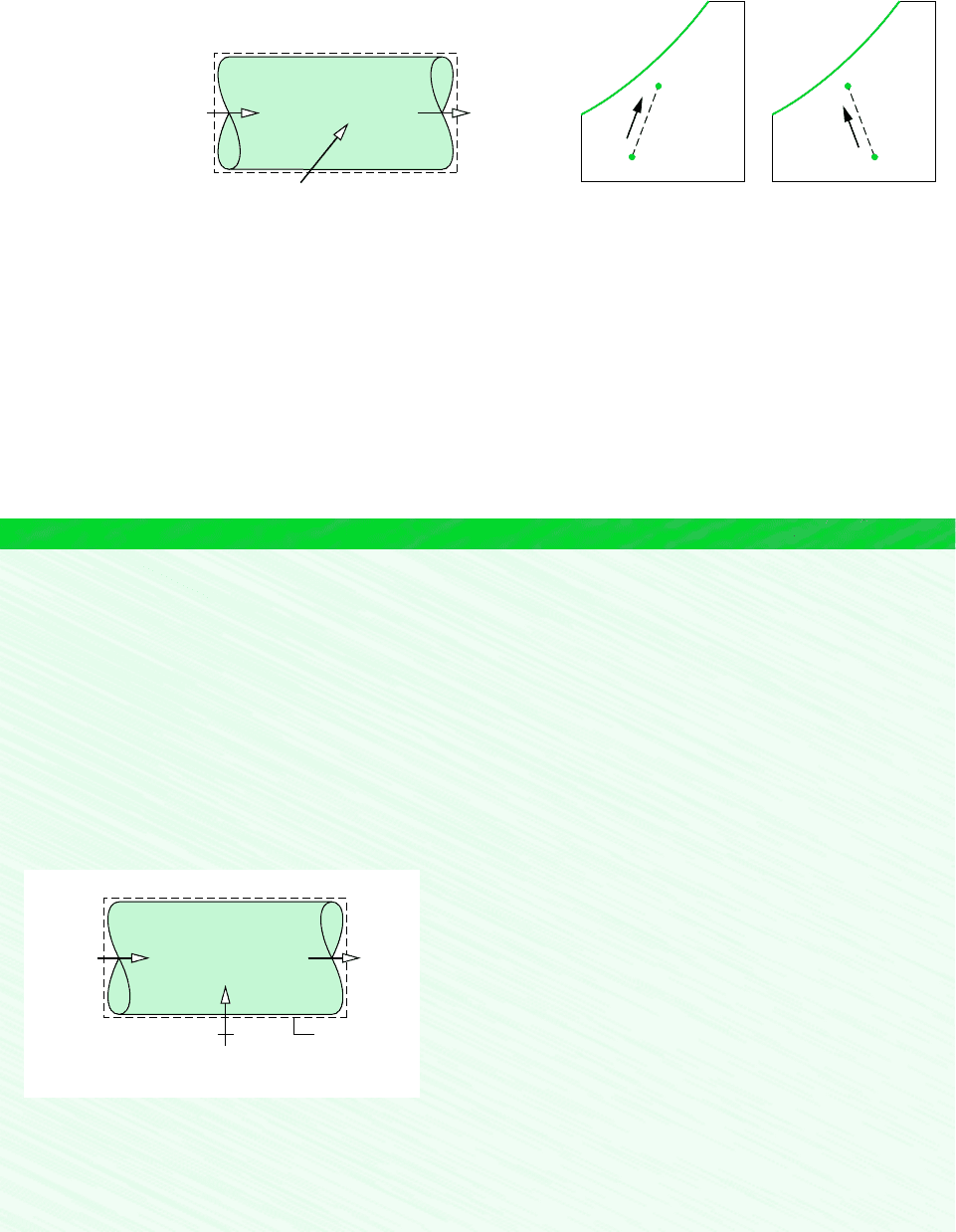
602 Chapter 12 Ideal Gas Mixture and Psychrometric Applications
T
2
> T
1
2
>
ω
1
ω
T
2
< T
1
2
>
ω
1
ω
2
2
1
1
ωω
Dry-bulb temperatureDry-bulb temperature
Moist air
T
1
,
1
ω
Moist air
T
2
,
2
>
1
ωω
12
Water injected
(vapor or liquid)
(a)(b)(c)
Figure 12.12 Humidification. (a) Control volume. (b) Steam injected. (c) Liquid injected.
the moist air as it exits the humidifier depends on the condition of the water introduced.
When relatively high-temperature steam is injected, both the humidity ratio and the dry-bulb
temperature would be increased. This is illustrated by the accompanying psychrometric chart
of Fig. 12.12b. If liquid water was injected instead of steam, the moist air may exit the
humidifier with a lower temperature than at the inlet. This is illustrated in Fig. 12.12c. The
example to follow illustrates the case of steam injection. The case of liquid water injection
is considered further in the next section.
EXAMPLE 12.12 Steam-Spray Humidifier
Moist air with a temperature of 22C and a wet-bulb temperature of 9C enters a steam-spray humidifier. The mass flow rate
of the dry air is 90 kg/min. Saturated water vapor at 110C is injected into the mixture at a rate of 52 kg/h. There is no heat
transfer with the surroundings, and the pressure is constant throughout at 1 bar. Using the psychrometric chart, determine at
the exit
(a) the humidity ratio and (b) the temperature, in C.
SOLUTION
Known: Moist air enters a humidifier at a temperature of 22C and a wet-bulb temperature of 9C. The mass flow rate of
the dry air is 90 kg/min. Saturated water vapor at 110C is injected into the mixture at a rate of 52 kg/h.
Find: Using the psychrometric chart, determine at the exit the humidity ratio and the temperature, in C.
Schematic and Given Data:
Moist air
T
2
= ?
2
= ?
ω
3
m
a
=
90 kg/min
·
T
1
= 22°C
T
wb
= 9°C
Saturated water vapor
at 110°C, m
st
= 52 kg/h
·
Boundary
12
Figure E12.12
Assumptions:
1. The control volume shown in the accompanying figure operates
at steady state. Changes in kinetic and potential energy can be neg-
lected and
2. There is no heat transfer with the surroundings.
3. The pressure remains constant throughout at 1 bar. Figure A-9
remains valid at this pressure.
W
#
cv
0.
Analysis: (a) The humidity ratio at the exit
2
can be found from mass rate balances on the dry air and water individually. Thus
m
#
v1
m
#
st
m
#
v2
1water2
m
#
a1
m
#
a2
1dry air2

12.8 Analyzing Air-Conditioning Processes 603
With and where is the mass flow rate of the air, the second of these becomes
Using the inlet dry-bulb temperature, 22C, and the inlet wet-bulb temperature, 9C, the value of the humidity ratio
1
can be
found by inspection of the psychrometric chart, Fig. A-9. The result is
1
0.002 kg(vapor)kg(dry air). This value should
be verified as an exercise. Inserting values into the expression for
2
(b) The temperature at the exit can be determined using an energy rate balance. With assumptions 1 and 2, the steady-state
form of the energy rate balance reduces to a special case of Eq. 12.55. Namely
(1)
In writing this, the specific enthalpies of the water vapor at 1 and 2 are evaluated as the respective saturated vapor values, and
h
g3
denotes the enthalpy of the saturated vapor injected into the moist air.
Equation (1) can be rearranged in the following form suitable for use with the psychrometric chart.
(2)
The first term on the right can be obtained from Fig. A-9 at the state defined by the intersection of the inlet dry-bulb tem-
perature, 22C, and the inlet wet-bulb temperature, 9C: 27.2 kJ/kg(dry air). The second term on the right can be evaluated
with the known humidity ratios
1
and
2
and the value of h
g3
from Table A-2: 2691.5 kJ/kg(vapor). The state at the exit is
fixed by
2
and (h
a
h
g
)
2
53 kJ/kg(dry air). The temperature at the exit can then be read directly from the chart. The
result is
Alternative Solution:
The following program allows T
2
to be determined using IT, where is denoted as mdota, is denoted as mdotst, w1
and w2 denote
1
and
2
, respectively, and so on.
// Given data
T1 = 22 // C
Twb1 = 9 // C
mdota = 90 // kg/min
p = 1 // bar
Tst = 110 // C
mdotst = (52 / 60) // converting kg/h to kg/min
// Evaluate humidity ratios
w1 = w_TTwb(T1,Twb1,p)
w2 = w1 + (mdotst / mdota)
// Denoting the enthalpy of moist air at state 1 by
// h1, etc., the energy balance, Eq. (1), becomes
0 = h1 – h2 + (w2 – w1)*hst
// Evaluate enthalpies
h1 = ha_Tw(T1,w1)
h2 = ha_Tw(T2,w2)
hst = hsat_Px(“Water/Steam”,psat,1)
psat = Psat_T(“Water/Steam”,Tst)
Using the Solve button, the result is T
2
23.4C, which agrees closely with the values obtained above, as expected.
A solution of Eq. (2) using data from Tables A-2 and A-22 requires an iterative (trial) procedure. The result is T
2
24C,
as can be verified.
Note the use of special Moist Air functions listed in the Properties menu of IT.
m
#
st
m
#
a
T
2
23.5°C.
1h
a
vh
g
2
2
1h
a
vh
g
2
1
1v
2
v
1
2
h
g3
0 h
a1
h
a2
v
1
h
g1
1v
2
v
1
2
h
g3
v
2
h
g2
v
2
0.002
152 kg/h201 h
60 min 0
90 kg/min
0.0116
kg1vapor2
kg1dry air2
v
2
v
1
m
#
st
m
#
a
m
#
a
m
#
v2
v
2
m
#
a
,m
#
v1
v
1
m
#
a
,
❶
❷
❶
❷
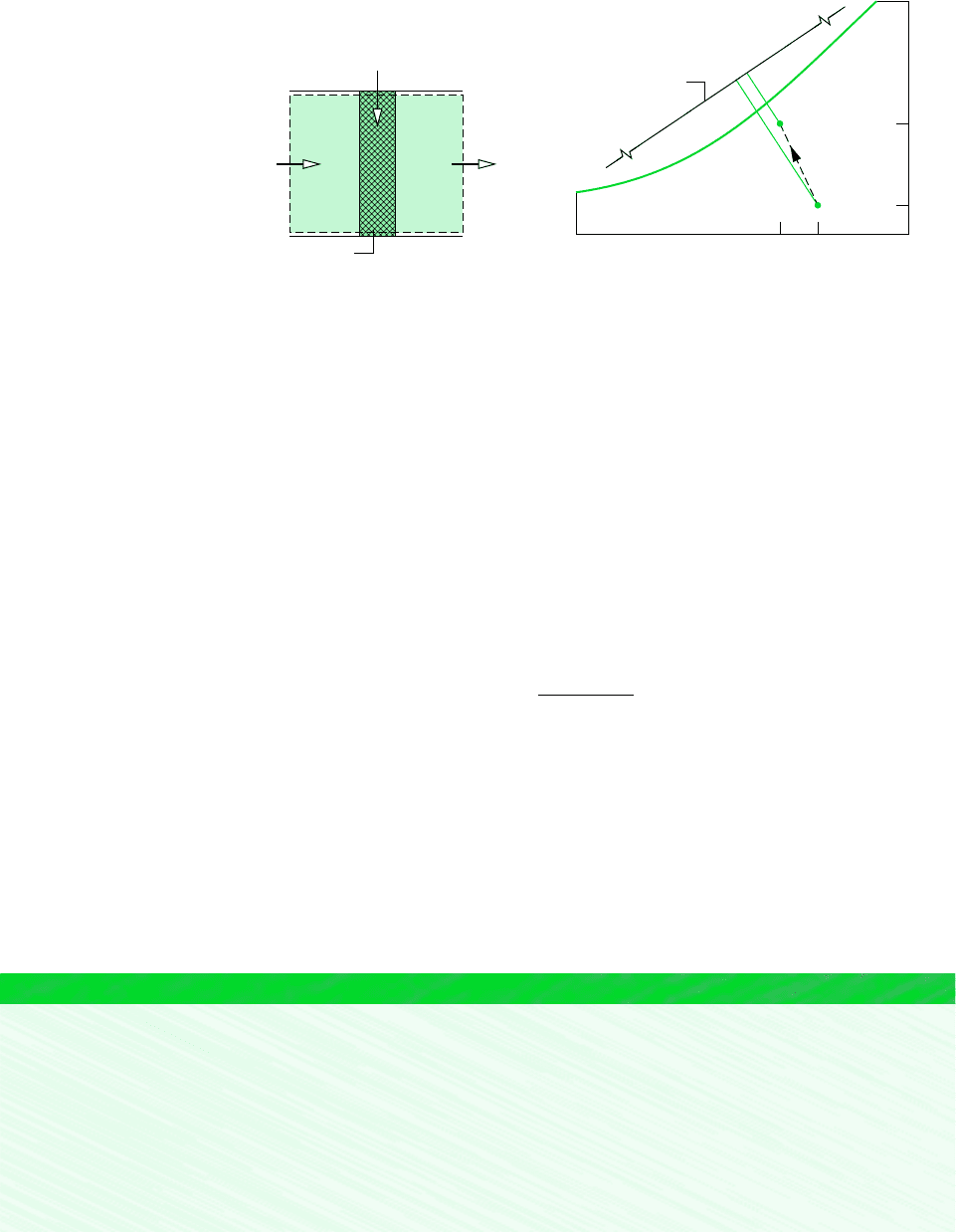
604 Chapter 12 Ideal Gas Mixture and Psychrometric Applications
12.8.5 Evaporative Cooling
Cooling in hot, relatively dry climates can be accomplished by evaporative cooling. This in-
volves either spraying liquid water into air or forcing air through a soaked pad that is kept
replenished with water, as shown in Fig. 12.13. Owing to the low humidity of the moist air
entering at state 1, part of the injected water evaporates. The energy for evaporation is pro-
vided by the air stream, which is reduced in temperature and exits at state 2 with a lower
temperature than the entering stream. Because the incoming air is relatively dry, the addi-
tional moisture carried by the exiting moist air stream is normally beneficial.
For negligible heat transfer with the surroundings, no work , and no significant changes
in kinetic and potential energy, the steady-state forms of the mass and energy rate balances
reduce for the control volume of Fig. 12.13a to
where h
f
denotes the specific enthalpy of the liquid stream entering the control volume. All
the injected water is assumed to evaporate into the moist air stream. The underlined term
accounts for the energy carried in with the injected liquid water. This term is normally much
smaller in magnitude than either of the two moist air enthalpy terms. Accordingly, the enthalpy
of the moist air varies only slightly, as illustrated on the psychrometric chart of Fig. 12.13b.
Recalling that lines of constant mixture enthalpy are closely lines of constant wet-bulb tem-
perature (Sec. 12.7), it follows that evaporative cooling takes place at a nearly constant wet-
bulb temperature.
In the next example, we consider the analysis of an evaporative cooler.
1h
a2
v
2
h
g2
2 1v
2
v
1
2h
f
1h
a1
v
1
h
g1
2
W
#
cv
Moist air
m
a
, T
1
,
ω
1
T
2
< T
1
2
>
1
ωω
Water at T
w
Soaked
pad
(a) (b)
Dry-bulb temperature
Mixture enthalpy
per unit mass
of dry air
T
2
T
1
ω
2
ω
1
1
2
ω
12
·
Figure 12.13 Evaporative cooling. (a) Equipment schematic. (b) Psychrometric chart
representation.
EXAMPLE 12.13 Evaporative Cooler
Air at 38C and 10% relative humidity enters an evaporative cooler with a volumetric flow rate of 140 m
3
/min. Moist air exits
the cooler at 21C. Water is added to the soaked pad of the cooler as a liquid at 21C and evaporates fully into the moist air.
There is no heat transfer with the surroundings and the pressure is constant throughout at 1 atm. Determine (a) the mass flow
rate of the water to the soaked pad, in lb/h, and (b) the relative humidity of the moist air at the exit to the evaporative cooler.
SOLUTION
Known: Air at 38C and 10% enters an evaporative cooler with a volumetric flow rate of 140 m
3
/min. Moist air exits
the cooler at 21C. Water is added to the soaked pad of the cooler at 21C.
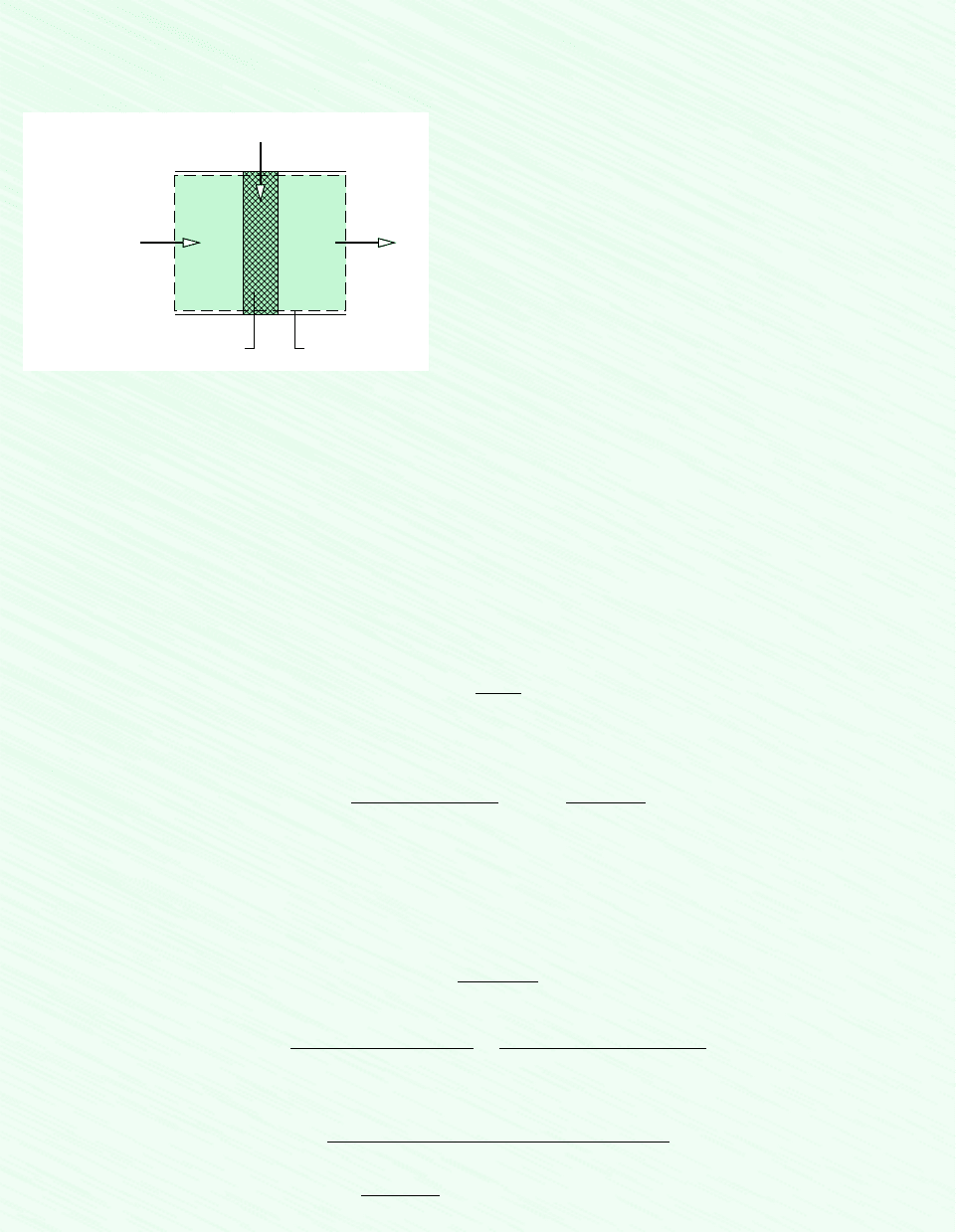
12.8 Analyzing Air-Conditioning Processes 605
Find: Determine the mass flow rate of the water to the soaked pad, in lb/h, and the relative humidity of the moist air at the
exit of the cooler.
Schematic and Given Data:
Analysis:
(a) Applying conservation of mass to the dry air and water individually as in previous examples gives
where is the mass flow rate of the water to the soaked pad. To find requires
1
, , and
2
. These will now be evalu-
ated in turn.
The humidity ratio
1
can be found from Eq. 12.43, which requires p
v1
, the partial pressure of the moist air entering the
control volume. Using the given relative humidity
1
and p
g
at T
1
from Table A-2, we have p
v1
1
p
g1
0.0066 bar. With
this,
1
0.00408 kg(vapor)kg(dry air).
The mass flow rate of the dry air can be found as in previous examples using the volumetric flow rate and specific vol-
ume of the dry air. Thus
The specific volume of the dry air can be evaluated from the ideal gas equation of state. The result is v
a1
0.887 m
3
/kg(dry air).
Inserting values, the mass flow rate of the dry air is
To find the humidity ratio
2
, reduce the steady-state forms of the mass and energy rate balances using assumption 1 to
obtain
With the same reasoning as in previous examples, this can be expressed as
where h
f
denotes the specific enthalpy of the water entering the control volume at 21C. Solving for
2
where c
pa
1.005 kJ/kg K. With h
f
, h
g1
, and h
g2
from Table A-2
.011
kg1vapor2
kg1dry air2
v
2
11.0052
138 212 0.00408 12570.7 88.142
2451.8
#
v
2
h
a1
h
a2
v
1
1h
g1
h
f
2
h
g2
h
f
c
pa
1T
1
T
2
2 v
1
1h
g1
h
f
2
h
g2
h
f
0 1h
a
vh
g
2
1
1v
2
v
1
2h
f
1h
a
vh
g
2
2
0 1m
#
a
h
a1
m
#
v1
h
v1
2 m
#
w
h
w
1m
#
a
h
a2
m
#
v2
h
v2
2
m
#
a
140 m
3
/min
0.887 m
3
/kg1dry air2
157.8
kg1dry air2
min
m
#
a
1AV2
1
v
a1
m
#
a
m
#
a
m
#
w
m
#
w
m
#
w
m
#
a
1v
2
v
1
2
Water at 21C
T
2
= 21C
Boundary
21
Soaked pad
T
1
1
= 38C
= 10%
φ
m
3
___
min
(AV)
1
= 140
Figure E12.13
Assumptions:
1. The control volume shown in the accompanying figure oper-
ates at steady state. Changes in kinetic and potential energy can
be neglected and .
2. There is no heat transfer with the surroundings.
3. The water added to the soaked pad enters as a liquid and evap-
orates fully into the moist air.
4. The pressure remains constant throughout at 1 atm.
W
#
cv
0
❶
❷
